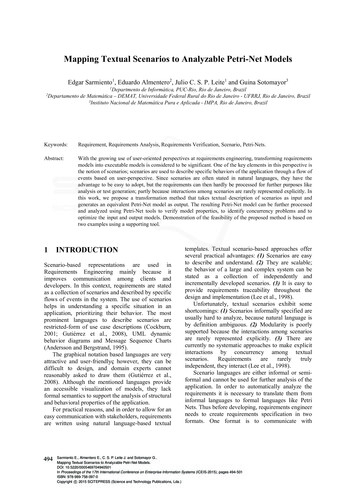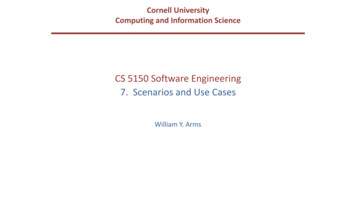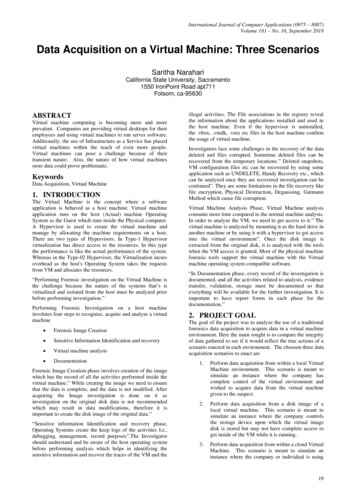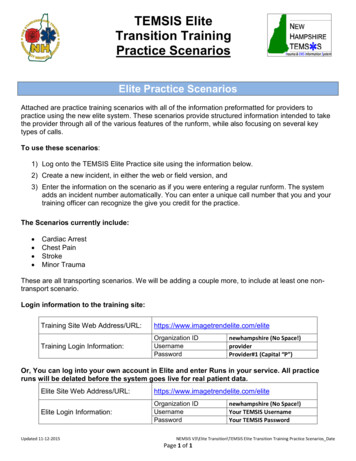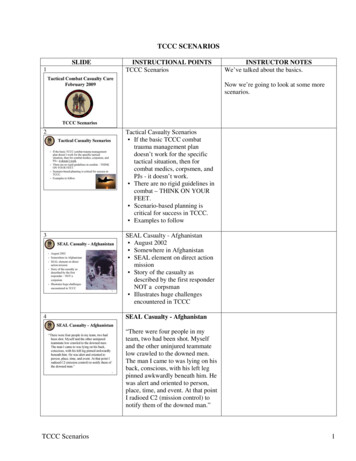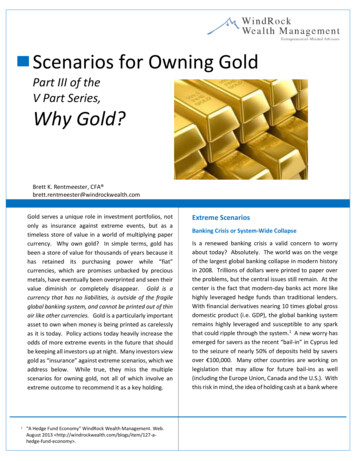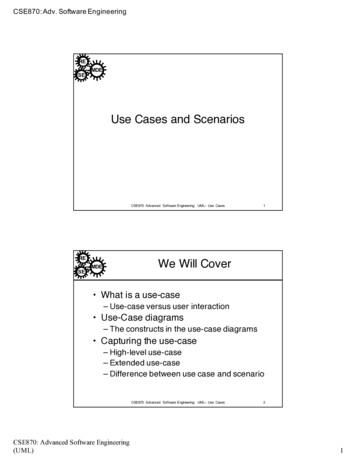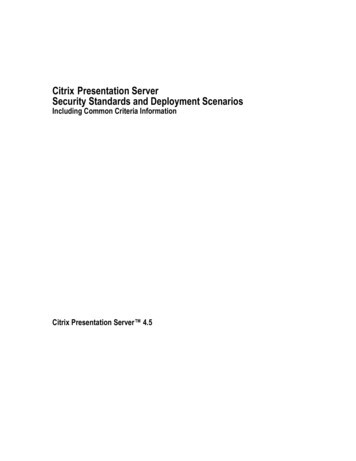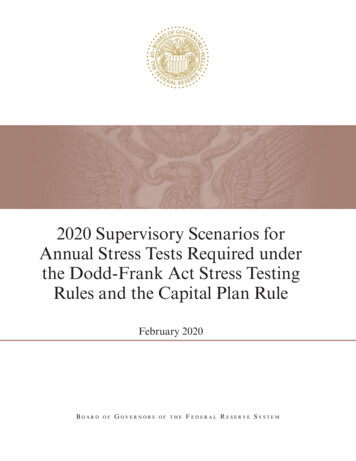
Transcription
2020 Supervisory Scenarios forAnnual Stress Tests Required underthe Dodd-Frank Act Stress TestingRules and the Capital Plan RuleFebruary 2020BOARDOFGOVERNORSOF THEFEDERAL RESERVE SYSTEM
2020 Supervisory Scenarios forAnnual Stress Tests Required underthe Dodd-Frank Act Stress TestingRules and the Capital Plan RuleFebruary 2020BOARDOFGOVERNORSOF THEFEDERAL RESERVE SYSTEM
This and other Federal Reserve Board reports and publications are available online ult.htm.To order copies of Federal Reserve Board publications offered in print,see the Board’s Publication Order Form f)or contact:Printing and FulfillmentMail Stop K1-120Board of Governors of the Federal Reserve SystemWashington, DC 20551(ph) 202-452-3245(fax) 202-728-5886(email) Publications-BOG@frb.gov
iiiContentsIntroduction . 1Supervisory Scenarios. 3Baseline and Severely Adverse Scenarios . 3Global Market Shock Component for Supervisory Severely Adverse Scenario . 5Counterparty Default Component for Supervisory Severely Adverse Scenario . 7Variables for the Supervisory Scenarios. 9
1IntroductionThe Federal Reserve Board conducts supervisorystress tests to help ensure that large bank holdingcompanies operating in the United States will be ableto lend to households and businesses even in a severerecession. The tests are known as the Dodd-FrankAct stress test (DFAST) and the ComprehensiveCapital Analysis and Review (CCAR).1DFAST is a forward-looking assessment of the capital adequacy of holding companies that uses standard assumptions across all covered firms. CCARevaluates the capital planning practices and capital1U.S. bank holding companies (U.S. BHCs) and U.S. intermediate holding companies of foreign banking organizations (U.S.IHCs) with 100 billion or more in assets are subject to theBoard’s supervisory stress test rule (12 CFR 252, subpart E)and the capital plan rule (12 CFR 225.8). In addition, certainU.S. BHCs, U.S. IHCs, savings and loan holding companies,and state member banks must comply with the Board’scompany-run stress test rules. (12 CFR 238, subpart P;12 CFR 252, subpart B; and 12 CFR 252, subpart F).adequacy of holding companies using capitalactions, such as dividend payments and share repurchases, planned by those firms.This publication describes the two supervisory scenarios—baseline and severely adverse—that theBoard will use in its supervisory stress tests this year;that a firm must use in conducting its company-runstress test; and that a firm must use to estimate projected revenues, losses, reserves, and pro forma capital levels as part of its 2020 capital plan submission.2This publication also details additional components—the global market shock component and thecounterparty default component—that the largestand most complex firms must incorporate into thesupervisory scenarios.2See 12 CFR 225.8; 12 CFR 238.143(b); 12 CFR 252.14(b); and12 CFR 252.54(b).
3Supervisory ScenariosThe severely adverse scenario describes a hypotheticalset of conditions designed to assess the strength ofbanking organizations and their resilience to anadverse economic environment. The baseline scenariofollows a profile similar to average projections from asurvey of economic forecasters. These scenarios arenot Federal Reserve forecasts.3The scenarios start in the first quarter of 2020 andextend through the first quarter of 2023. Each scenario includes 28 variables; this set of variables is thesame as the set provided in last year’s supervisoryscenarios. The variables describing economic developments within the United States include:Six measures of economic activity and prices: percentchanges (at an annual rate) in real and nominal grossdomestic product (GDP), the unemployment rate ofthe civilian non-institutional population aged16 years and over, percent changes (at an annualrate) in real and nominal disposable personal income,and the percent change (at an annual rate) in theConsumer Price Index (CPI);Four aggregate measures of asset prices or financialconditions: indexes of house prices, commercial realestate prices, equity prices, and U.S. stock marketvolatility; andSix measures of interest rates: the rate on 3-monthTreasury bills; the yield for 5-year Treasury notes;the yield for 10-year Treasury notes; the yield for10-year BBB corporate securities; the interest rateassociated with conforming, conventional, 30-yearfixed-rate mortgages; and the prime rate.The variables describing international economic conditions in each scenario include three variables infour countries or country blocs:The three variables for each country or country bloc:the percent change (at an annual rate) in real GDP,the percent change (at an annual rate) in the CPI orlocal equivalent, and the level of the U.S. dollarexchange rate.The four countries or country blocs included: the euroarea (the 19 European Union member states thathave adopted the euro as their common currency);the United Kingdom; developing Asia (the nominalGDP-weighted aggregate of China, India, SouthKorea, Hong Kong Special Administrative Region,and Taiwan); and Japan.Baseline and Severely AdverseScenariosThe following sections describe the baseline andseverely adverse scenarios. The variables included inthese scenarios are provided in tables at the end ofthis document. They can also be downloaded(together with the historical time series of the variables) from the Board’s website, at ss-tests.htm.Historical data for the domestic and the internationalvariables are reported in Table 1.A and Table 1.B,respectively.Baseline ScenarioThe baseline outlook for U.S. real activity, inflation,and interest rates (see Table 2.A) is similar to theJanuary 2020 consensus projections from Blue ChipEconomic Indicators.4 This scenario does not represent a forecast of the Federal Reserve.3For more information about the Federal Reserve’s frameworkfor designing stress-test scenarios, see 12 CFR 252, Appendix A.4See Wolters Kluwer Legal and Regulatory Solutions, Blue ChipEconomic Indicators.
4Federal Reserve Supervisory ScenariosThe baseline scenario for the United States is a moderate economic expansion over the 13-quarter stresstest period. Real GDP growth averages 1¾ percent(annual rate) in 2020, picks up to 2 percent by theend of 2021, and remains at that level in 2022. Theunemployment rate ticks up to about 3¾ percent bythe end of 2020, then increases to about 4 percent inearly 2022, and remains at that level for the rest ofthe scenario period. Quarterly CPI inflation is relatively steady over the 13–quarter period, rangingfrom 2 to 2¼ percent at an annual rate.Accompanying the moderate economic expansion,short-term Treasury rates are assumed to initiallydecline to slightly below 1½ percent by the end of2020, remain around that level through the end of2021, and then rise to 1¾ percent by the end of thestress-test period. Longer-dated Treasury yields areassumed to rise modestly over time, consistent withsome steepening of the yield curve. Yields on 10-yearTreasury securities rise gradually from 1¾ percent inearly 2020 to 2¾ percent at the end of the scenarioperiod. The prime rate moves in line with short-termTreasury rates, while both corporate bond yields andmortgage rates rise in line with long-term Treasuryyields. Equity prices rise 4½ percent in 2020 andabout 4¾ percent per year thereafter. Equity marketvolatility, as captured by the VIX, rises graduallyfrom 22¾ in early 2020 to 26½ by the end of the scenario period. Nominal house prices rise 2¼ percentin 2020 and 2021, and about 3¼ percent in 2022. Thegrowth rate of commercial real estate prices averagesabout 5 percent in 2020 and 2021, and 2¾ percent in2022.The baseline paths for the international variables (seeTable 2.B) are similar to the trajectories reported inthe January 2020 Blue Chip Economic Indicators andthe International Monetary Fund’s October 2019World Economic Outlook.5 The baseline scenario features a relatively steady expansion in internationaleconomic activity, albeit at a different pace across thefour country blocs: Real GDP growth in developingAsia averages 5¾ percent per year through the scenario period, real GDP growth in the euro area averages about 1¼ percent, and real GDP growth inJapan averages about ¾ percent. Finally, real GDPgrowth in the United Kingdom averages just over1¼ percent over the scenario period.5See International Monetary Fund, World Economic Outlook(October 2019), ly Adverse ScenarioThe severely adverse scenario is characterized by asevere global recession accompanied by a period ofheightened stress in commercial real estate and corporate debt markets. This is a hypothetical scenariodesigned to assess the strength of banking organizations and their resilience to unfavorable economicconditions and does not represent a forecast of theFederal Reserve.The U.S. unemployment rate climbs to a peak of10 percent in the third quarter of 2021 (seeTable 3.A). This substantial increase in the unemployment rate is consistent with the Board’s PolicyStatement on the Scenario Design Framework forStress Testing.6 In line with the increase in the unemployment rate, real GDP falls about 8½ percent fromits pre-recession peak, reaching a trough in the thirdquarter of 2021. The decline in activity is accompanied by a lower headline CPI inflation rate, whichfalls to an annual rate of about 1¼ percent after thefirst quarter of 2020, before gradually rising to average 1¾ percent in 2022.In line with the severe decline in real activity, theinterest rate for 3-month Treasury bills immediatelyfalls near zero and remains at that level through theend of the scenario. The 10-year Treasury yieldimmediately falls to ¾ percent during the first quarter of 2020 and rises gradually thereafter to 2¼ percent by the end of the stress-test period. The result isa gradual steepening of the yield curve over most ofthe stress-test period. Financial conditions in corporate and real estate lending markets are stressedseverely. The spread between yields on investmentgrade corporate bonds and yields on long-termTreasury securities widens to 5½ percentage pointsby the third quarter of 2020, an increase of 4 percentage points relative to the fourth quarter of 2019.The spread between mortgage rates and 10-yearTreasury yields widens to 3½ percentage points overthe same period.Asset prices drop sharply in this scenario. Equityprices fall 50 percent through the end of 2020,accompanied by a rise in the VIX, which reaches apeak of 70. House prices and commercial real estateprices also experience large overall declines of about28 percent and 35 percent, respectively, during thefirst nine quarters of the scenario.6See 12 CFR 252, Appendix A.
February 2020The international component of this scenario features sharp slowdowns in all country blocs, leadingto severe recessions in the euro area, the UnitedKingdom, and Japan and a pronounced decelerationof activity in developing Asia. As a result of thesharp contraction in economic activity, three of theforeign economies included in the scenario—theeuro area, Japan, and developing Asia—experiencesharp declines in inflation rates. The U.S. dollarappreciates against the euro, the pound sterling, andthe currencies of developing Asia, but depreciatesmodestly against the yen because of flight-to-safetycapital flows.Comparison of the 2020 Severely AdverseScenario and the 2019 Severely AdverseScenarioThis year’s severely adverse scenario features aslightly greater increase in the unemployment rate inthe United States compared to last year’s severelyadverse scenario. This difference reflects the Board’sPolicy Statement on the Scenario Design Frameworkfor Stress Testing, which calls for a more pronouncedeconomic downturn when current conditions arestronger. Given a lower unemployment rate at thebeginning of this year’s scenario compared to lastyear’s, the framework calls for a correspondinglylarger increase in the unemployment rate in order toreach a peak of 10 percent. In this year’s scenario,interest rates do not fall as much as in last year’s scenario, given their lower starting values. The declinesin equity prices, house prices, and commercial realestate prices are similar to the declines in last year’sseverely adverse scenario.Additional Key Features of the SeverelyAdverse ScenarioAlthough the weakness in euro area economic conditions reflects a broad-based contraction in euro areademand, this contraction is assumed to be more protracted in countries with less room for fiscal policystabilization. The sharp slowdown in developingAsia should be assumed to be representative of conditions across emerging market economies.assumed to be representative of risks to house pricesand commercial real estate prices in foreign regionsand economies that have experienced rapid pricegains over the past two years.Global Market Shock Component forSupervisory Severely AdverseScenarioThe global market shock is a set of hypotheticalshocks to a large set of risk factors reflecting generalmarket distress and heightened uncertainty. Firmswith significant trading activity must consider theglobal market shock as part of their supervisoryseverely adverse scenario, and recognize associatedlosses in the first quarter of the planning period.7 Inaddition, certain large and highly interconnectedfirms must apply the same global market shock toproject losses under the counterparty default scenario component. The global market shock isapplied to asset positions held by the firms on agiven as-of date. The as-of date for the global marketshock is October 18, 2019.8 These shocks do not represent a forecast of the Federal Reserve.The design and specification of the global marketshock differ from that of the macroeconomic scenarios for several reasons. First, profits and lossesfrom trading and counterparty credit are measuredin mark-to-market terms, while revenues and lossesfrom traditional banking are generally measuredusing the accrual method. Another key difference isthe timing of loss recognition. The global marketshock affects the mark-to-market value of tradingpositions and counterparty credit losses in the firstquarter of the projection horizon. This timing isbased on an observation that market dislocations canhappen rapidly and unpredictably any time understress conditions. Applying the global market shockin the first quarter of the projection horizon ensuresthat potential losses from trading and counterpartyexposures are incorporated into trading companies’capital ratios at all points in the projection horizon.7Stresses in the corporate loan market should beassumed to be more intense for lower-rated firms.Declines in aggregate U.S. residential and commercial real estate prices is assumed to be concentratedin regions that have experienced rapid price gainsover the past two years. Declines in prices of U.S.housing and commercial real estate should also be58The global market shock component applies to a firm that issubject to the supervisory stress test and that has aggregatetrading assets and liabilities of 50 billion or more, or aggregatetrading assets and liabilities equal to 10 percent or more of totalconsolidated assets, and is not a large and noncomplex firmunder the Board’s capital plan rule (12 CFR 225.8).A firm may use data as of the date that corresponds to itsweekly internal risk reporting cycle as long as it falls during thebusiness week of the as-of date for the global market shock(i.e., October 14–18, 2019).
6Federal Reserve Supervisory ScenariosThe global market shock component is specified by alarge set of risk factors that include, but are not limited to: Equity prices of key developed markets and developing and emerging market nations to which trading companies may have exposure, along withselected points along term structures of impliedvolatilities; Foreign exchange rates of most advanced economyand some emerging economy currencies, alongwith selected points along term structures ofimplied volatilities; Selected maturity government rates (e.g., U.S.Treasuries), swap rates, and other key rates for keydeveloped markets and for developing and emerging market nations to which trading companiesmay have exposure; Selected maturities and expiries of implied volatilities that are key inputs to the pricing of interestrate derivatives; Selected expiries of futures prices for energy products including crude oil (differentiated by countryof origin), natural gas, and power;shock based on hypothetical events may result inchanges in risk factors that were not previouslyobserved.Risk factor shocks are calibrated based on assumedtime horizons. The calibration horizons reflect anumber of considerations related to the scenariobeing modeled. One important consideration is theliquidity characteristics of different risk factors,which vary based on the specified market shock narrative. More specifically, calibration horizons reflectthe variation in the speed at which trading companies could reasonably close out, or effectively hedge,risk exposures in the event of market stress. The calibration horizons are generally longer than the typicaltime needed to liquidate assets under normal conditions because they are designed to capture the unpredictable liquidity conditions that prevail in times ofstress, among other factors.9 For example, changeswithin more liquid markets, such as interest rates,foreign exchange, or public equities, are calibrated toshorter horizons, such as three months, whilechanges within less liquid markets, such as nonagency securitized products or private equities, havelonger calibration horizons, such as 12 months. Selected expiries of futures prices for metals andagricultural commodities; and2020 Severely Adverse Scenario Credit spreads or prices for selected credit-sensitiveproducts including corporate bonds, credit defaultswaps, and loans by risk; non-agency residentialmortgage-backed securities and commercialmortgage-backed securities by risk and vintage;sovereign debt; and municipal bonds.The 2020 global market shock component for theseverely adverse scenario is designed to be generallyconsistent with a macroeconomic background inwhich the U.S. economy has entered a sharp recession, characterized by widespread defaults on arange of debt instruments by business borrowers.Under the scenario, weaker obligors struggle tomaintain their financial conditions due to materialdeclines in earnings associated with the poor economic environment while rating agencies downgradelarge portions of debt outstanding. The historicallyhigh levels of nonfinancial corporate debt to GDPamplify the losses resulting from the wave of corporate sector defaults. This dynamic creates feedbackeffects between the economy and the corporate sector.The Board considers emerging and ongoing areas offinancial market vulnerability in the development ofthe global market shock. This assessment of potential vulnerabilities is informed by financial stabilityreports, supervisory information, and internal andexternal assessments of potential sources of distresssuch as geopolitical, economic, and financialmarket events.The global market shock includes a standardized setof risk factor shocks to financial market variablesthat apply to all firms with significant trading activity. Depending on the
Feb 06, 2020 · Capital Analysis and Review (CCAR).1 DFAST is a forward-looking assessment of the capi-tal adequacy of holding companies that uses stan-dard assumptions across all covered firms. CCAR evaluates the capital planning practices and capital adequacy of holding companies using ca


